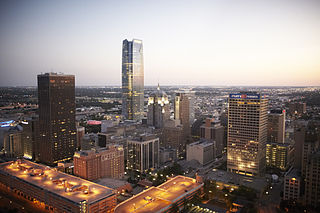
Oklahoma City, officially the City of Oklahoma City, and often shortened to OKC, is the capital and most populous city of the U.S. state of Oklahoma. The county seat of Oklahoma County, it ranks 20th among United States cities in population, and is the 8th largest city in the Southern United States. The population grew following the 2010 census and reached 681,054 in the 2020 census. The Oklahoma City metropolitan area had a population of 1,396,445, and the Oklahoma City–Shawnee Combined Statistical Area had a population of 1,469,124, making it Oklahoma's largest municipality and metropolitan area by population.

Moore is a city in Cleveland County, Oklahoma, United States, and is part of the Oklahoma City metropolitan area. The population was 62,793 at the 2020 census, making Moore the seventh-largest city in the state of Oklahoma.

Choctaw is a city in Oklahoma County, Oklahoma, United States, with a population of 12,182 at the 2020 census, a 9.3% increase from 2010. It is the oldest chartered town in Oklahoma Territory. The city is located approximately 10 miles (16.1 km) east of Oklahoma City and is part of the Oklahoma City metropolitan area.

Del City is a city in Oklahoma County, Oklahoma, United States, and a part of the Oklahoma City metropolitan area. The population was 21,822 at the United States Census, 2020, a 2.3% increase from 2010.

Midwest City is a city in Oklahoma County, Oklahoma, United States, and a part of the Oklahoma City metropolitan area. As of the 2020 census, the population was 58,409, making it the eighth largest city in the state.
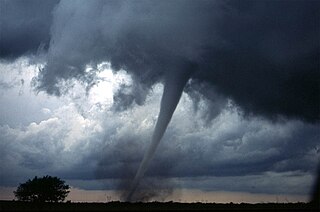
The 1999 Oklahoma tornado outbreak was a significant tornado outbreak that affected much of the Central and parts of the Eastern United States, with the highest record-breaking wind speeds of 301 ± 20 mph (484 ± 32 km/h). During this week-long event, 154 tornadoes touched down. More than half of them were on May 3 and 4 when activity reached its peak over Oklahoma, Kansas, Nebraska, Texas, and Arkansas.
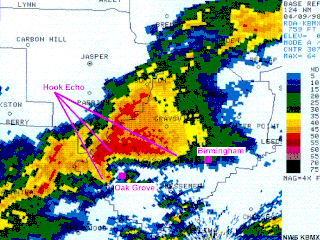
The tornado outbreak of April 6–9, 1998 was a large tornado outbreak that started on April 6 across the Great Plains and ended on April 9 across the Carolinas and Georgia. A total of 62 tornadoes touched down from the Middle Atlantic States to the Midwestern United States and Texas. The outbreak is infamous for producing a deadly F5 that tore through the suburbs of Birmingham, Alabama, killing 32 people. The Birmingham tornado was one of only two F5 tornadoes that year. The other hit in Lawrence County, Tennessee, on April 16, as part of the same outbreak as the Nashville F3 tornado. This tornado outbreak was responsible for 41 deaths: 7 in Georgia and 34 in Alabama.

Oklahoma City, like most other major cities, has a diversity of institutions for learning and educational enrichment. Several colleges and universities offer associate and bachelor's degrees and the state's teaching hospital, the University of Oklahoma Medical Center is located east of downtown.
Norman High School is a four-year public high school in Norman, Oklahoma, with a steady enrollment of approximately 2,000 students. It is accredited by North Central Association, the Oklahoma State Department of Education and the Oklahoma Secondary School Activities Association. The school year consists of two 15-week semesters with a 6 class flexible schedule, consisting of 52 minute periods. Norman High School is part of the Norman Independent School District No. 29 of Cleveland County, Oklahoma, more commonly known as Norman Public Schools (NPS). Norman High was ranked as one of the top 1,400 high schools in the United States in 2009.
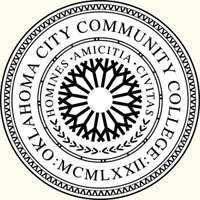
Oklahoma City Community College (OCCC) is a public community college in Oklahoma City, Oklahoma. The college was founded in 1972 as South Oklahoma City Junior College. OCCC has a current enrollment of 18,549 students and is the second largest community college and the fifth largest public higher education institution in Oklahoma. OCCC operates a main campus and three satellite locations in the south metro. A large percentage of OCCC students join or rejoin the local workforce each year. Their added skills translate to earnings of more than $220 million in annual additional income to Oklahoma's economy.

Mount Wachusett Community College (MWCC) is a public community college in Gardner, Massachusetts. Established by the Commonwealth of Massachusetts in 1963, it features an open admissions policy for the majority of its academic programs. MWCC offers more than 70 academic programs that allow students to earn either an associate of science degree (A.S.), associate of arts degree (A.A.), or a certificate.
In Oklahoma, Tech Prep is an administered through the Oklahoma Department of Career and Technology Education, located in Stillwater, Oklahoma. Tech Prep is funded through Section II of the Carl D. Perkins Career and Technical Education Act of 2006.
Star Spencer High School a.k.a. Star Spencer Mid-High School, is located in Spencer, Oklahoma. The official mascot for the school is the Bobcats. Star Spencer is part of the Oklahoma City Public Schools.

Hillcrest High School is a high school located at 3319 N. Grant Avenue in Springfield, Missouri. Hillcrest High School is one of five public high schools in Springfield Public Schools. It is located in the north part of Springfield. It was opened in 1958. As of 2015, there was an enrollment of 1,054 students, making it the smallest of the five public high schools in Springfield.

Northern Oklahoma College (NOC) is a public community college in Tonkawa, Oklahoma, with additional campuses located in Enid, Oklahoma and Stillwater, Oklahoma. Student enrollment is approximately 2,700. NOC bought the former Phillips University in Enid, Oklahoma, in 1999 and it became the NOC Enid campus.

Del City High School is the only public high school located in Del City, Oklahoma, U.S., and one of three high schools in the Mid-Del School District. The school opened in 1953. According to GreatSchools.org, the high school is rated above Midwest City High School and below Carl Albert High School, the other two high schools in the district. The school serves approximately 1,254 students. About a third of graduating students attend a four-year college.
Redlands Community College (Redlands) is a public community college in El Reno, Oklahoma. Student enrollment is approximately 2,200 per semester.
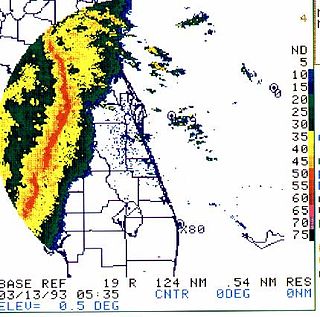
This page documents the tornadoes and tornado outbreaks of 1993, primarily in the United States. Most tornadoes form in the U.S., although some events may take place internationally. Tornado statistics for older years like this often appear significantly lower than modern years due to fewer reports or confirmed tornadoes, however by the 1990s tornado statistics were coming closer to the numbers we see today.
The Mid-Del School District is a school district based in the Oklahoma City metropolitan area. As of 2007, the school district included more than 14,500 K-12 students.

The 1999 Bridge Creek–Moore tornado was a large and exceptionally powerful F5 tornado in which the highest wind speeds ever measured globally were recorded at 301 ± 20 miles per hour (484 ± 32 km/h) by a Doppler on Wheels (DOW) radar. Considered the strongest tornado ever recorded to have affected the metropolitan area, the tornado while near peak intensity devastated southern portions of Oklahoma City, Oklahoma, United States, along with surrounding suburbs and towns to the south and southwest of the city during the early evening of Monday, May 3, 1999. Parts of Bridge Creek were rendered unrecognizable. The tornado covered 38 miles (61 km) during its 85-minute existence, destroying thousands of homes, killing 36 people, and leaving US$1 billion in damage, ranking it as the fifth-costliest on record not accounting for inflation. Its severity prompted the first-ever use of the tornado emergency statement by the National Weather Service.
















